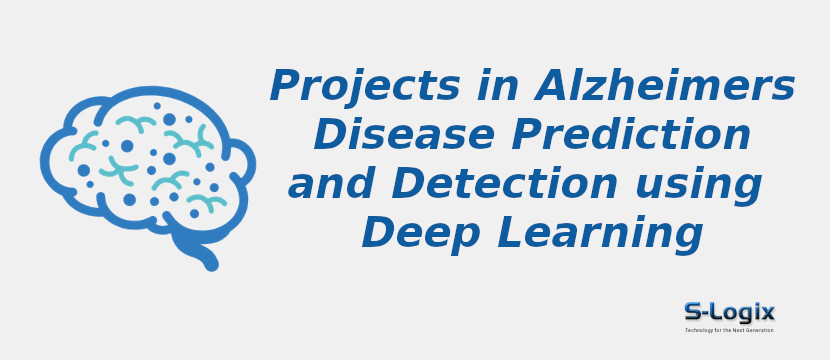Project Background:
Alzheimers disease prediction and detection using deep learning sets the stage for understanding the critical context and motivations behind the endeavor. Alzheimers disease is a progressive neurodegenerative disorder that affects millions of people worldwide with devastating consequences for patients. Early detection and accurate prediction of Alzheimers disease are pivotal for improving patient care, planning interventions, and advancing research efforts. This emphasizes the increasing prevalence of Alzheimer disease in an aging global population and putting immense strain on healthcare systems. This further highlights the significance of interpretable and transparent models to build trust among healthcare professionals and patients. It also highlights the potential of deep learning in addressing this challenge and emphasizes the importance of data collaboration, underscores the significance of model interpretability, and ultimately aims to improve patient care and contribute to the broader understanding of Alzheimers disease.
Problem Statement
- Alzheimers disease is a rapidly growing health concern with an aging global population characterized by progressive cognitive decline and poses significant challenges to affected individuals and healthcare systems.
- Early detection of Alzheimers disease is crucial for timely interventions and better patient care.
- Alzheimers prediction can leverage diverse data sources, including neuroimaging (MRI and PET scans) and cognitive assessments, to identify potential biomarkers and predictors of the disease.
- Successful Alzheimers prediction models require collaboration between healthcare institutions, researchers, and data providers. Large, well-annotated datasets are essential for effectively training and validating deep learning models.
- The models developed for Alzheimers prediction must be scalable and reliable, ensuring they can be deployed across various healthcare settings.
- Timely and accurate detection of Alzheimers disease is crucial for improving patient care, enabling early interventions, and potentially slowing down the disease progression.
- The deep learning models developed for Alzheimers disease detection must be interpretable and provide transparent explanations for predictions. This interpretability is crucial for gaining the trust of healthcare professionals and ensuring confident clinical decision-making.
Aim and Objectives
- To develop accurate early prediction and detection methods for Alzheimers disease using deep learning to improve patient health care and reduce the disease impact.
- Train deep learning models to predict the risk of Alzheimers disease based on diverse data sources.
- Develop deep learning-based tools for early detection and diagnosis of Alzheimers disease.
- Ensure the interpretability and transparency of models for clinical decision-making.
- Foster interdisciplinary collaboration for data collection, model development, and validation.
- Create scalable and reliable models for deployment in various healthcare sectors and settings.
- Reduce the emotional and financial burden on patients and their families through early detection.
- Contribute to the broader understanding of Alzheimers disease and potential interventions.
Contributions to Alzheimers Disease Prediction and Detection
1. In this project, the Alzheimers disease prediction and detection using deep learning are highly significant and have far-reaching implications for healthcare and research.
2. Deep learning models have the potential to enable early detection of Alzheimers disease, allowing for timely interventions and improved patient care. This can significantly enhance the quality of life for individuals affected by the disease.
3. These are capable of making accurate predictions based on diverse data sources, which offer valuable insights into an individual risk of developing Alzheimers disease.
4. The development of deep learning-based diagnostic tools can assist healthcare professionals in making more informed decisions regarding Alzheimers disease diagnosis.
5. It emphasizes the importance of creating interpretable and transparent models but also advances the broader understanding of the disease by providing insights into the features and factors driving predictions.
6. The development of scalable and reliable deep learning models ensures their practical deployment across various healthcare settings that can be used in primary care, specialized clinics, and research institutions.
7. Early detection and accurate prediction of Alzheimers disease can significantly reduce the emotional and financial burden on patients and contribute to an improved quality of life and a more sustainable healthcare system.
Deep Learning Algorithms for Alzheimers Disease Prediction and Detection
- Convolutional Neural Networks (CNN)
- Recurrent Neural Networks (RNN)
- Long Short-Term Memory (LSTM)
- Gated Recurrent Unit (GRU)
- Autoencoders
- Deep Belief Networks (DBN)
- Deep Residual Networks (ResNet)
- Variational Autoencoders (VAE)
- 3D Convolutional Neural Networks (3D CNN)
- Siamese Networks
- Random Forest with Deep Features
- Capsule Networks (CapsNet)
Datasets for Alzheimers Disease Prediction and Detection
- Alzheimers Disease Neuroimaging Initiative (ADNI)
- The National Alzheimers Coordinating Center (NACC) Dataset
- The Open Access Series of Imaging Studies (OASIS)
- The Alzheimers Disease Data Initiative (ADDI)
- The PredictAD Dataset
- The Human Connectome Project (HCP)
- The Framingham Heart Study (FHS)
- The DementiaBank Dataset
- The Genetics, Cognition, and Neuroimaging (GCNK) Dataset
- The Integrated NeuroCognitive Imaging Informatics (iN3) Dataset
- The Alzheimers Disease Imaging Initiative (ADNI2)
Performance Metrics
- Accuracy
- Sensitivity (True Positive Rate)
- Specificity (True Negative Rate)
- Precision
- Recall
- F1-Score
- Receiver Operating Characteristic (ROC) Curve
- Area Under the ROC Curve (AUC-ROC)
- Precision-Recall Curve
- Area Under the Precision-Recall Curve (AUC-PR)
- Matthews Correlation Coefficient (MCC)
- Mean Absolute Error (MAE)
- Root Mean Squared Error (RMSE)
- Log Loss
- Kappa Statistic
Software Tools and Technologies:
Operating System: Ubuntu 18.04 LTS 64bit / Windows 10
Development Tools: Anaconda3, Spyder 5.0, Jupyter Notebook
Language Version: Python 3.9
Python Libraries:
1. Python ML Libraries:
- Scikit-Learn
- Numpy
- Pandas
- Matplotlib
- Seaborn
- Docker
- MLflow
2. Deep Learning Frameworks:
- Keras
- TensorFlow
- PyTorch
